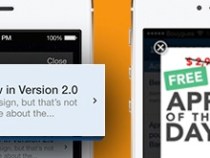
Appsfire, the makers of a suite of tools for mobile app developers acquire users, keep them engaged, and manage their advertising, has today released the second version of its app marketing SDK, which is free to use. The SDK, now iOS 7-friendly, offers features including engagement tools for in-app communication, feedback mechanisms, push notifications, as well as a new ad unit which Appsfire co-founder and CEO Ouriel Ohayon says is designed to “kill the banner.”
“Developers, for lack of time, pay little attention as to the ad experience in their app. they can create great apps, but will ruin it with crappy ads,” he tells us. So Appsfire wanted to introduce an ad until that internally they had been calling “Sashimi” before launch. (Apparently, they code-name all their unit after various sushi names, we hear.)
The new unit doesn't require any creative, as ads are automatically designed based on App Store data which can then be translated into 13 different languages, and optimized for landscape or iPad mode, if desired. In addition, the unit contains a clear call to action (no tricks), and lets downloads take place in the app without disruption. Or, as Ohayon describes it, it's “and iAd-like experience, but without the banner.”
When a user clicks to download the advertised app, the App Store slides up over top the developer's app, the user taps download, and then the App Store slides back down, returning users to the app.
Another nice feature is that the ad unit can be optimized to not show any ads the users already own, allowing app publishers to not waste their inventory. The solution also integrates with MoPub, AdMob and Burstly.
According to tests the company has already run ahead of the official launch, these new ads have seen click-through rates of above 10 percent, and conversion rates above 25% – figures which are well above averages for banners, and more in line with app lists or panel ad units instead.
The company is now working on organic ads, which will be designed to better fit in with the app they appear within.
Ohayon points out that developers are not required to use the new ads if they install the updated SDK, or they can choose to use them as a way to promote their own apps, instead.
The SDK works on iOS, Android and is integrated with Unity, Cordova, and Phonegap, too.
Appsfire, you may recall, started out life as an app discovery service, which is still live. Ohayon says its flagship consumer-facing app has seen 12 million downloads to date (8,000-10,000 per day). But now the larger focus for the business is helping developers keep their users after the download through its marketing tools. Eighteen months ago, the team rolled out discovery and engagement tools for developers, and today its vision is to offer a full solution which includes these plus more tools for monetization…like the new ads, for instance.
The company also now has a newer Silicon Valley location where Ohayon has relocated, and claims 1,000 developers on its platform, including Magisto, Mail.Ru, Perfect365, Macphun, Natural Motion, FreshPlanet (SongPop, MoviePop), My Little Paris, and others. Combined, it reaches 160 million unique devices, has sent 50 million notifications to date, and 30,000 feedback messages from developers to users.
ConversionConversion EmoticonEmoticon